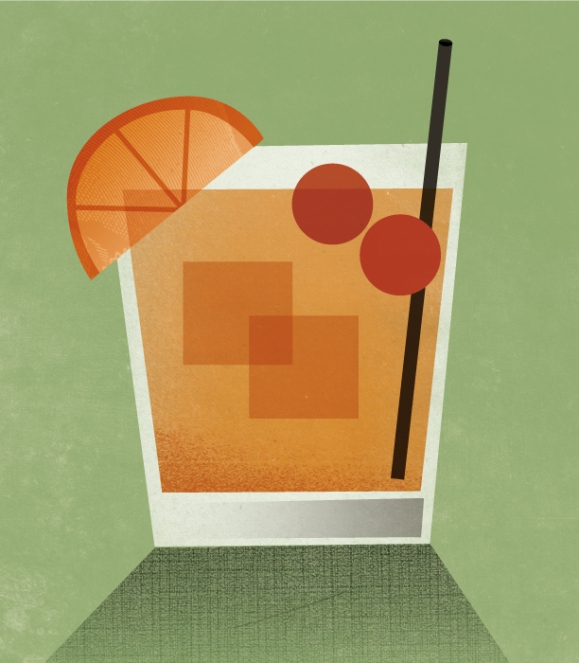Written by KELSEY PARRIS
Usually when I pour myself a drink, I’m not thinking about the medicinal properties of my cocktail. That is, until I read Warren Bobrow’s new book, Apothecary Cocktails: Restorative Drinks from Yesterday and Today. In it, OKRA Magazine’s esteemed whiskey expert goes back to his family roots and gives us a fascinating new book exploring the healing powers of our favorite cocktails.
It is full of beautiful photos of delicious looking drinks, split into categories of the ailments that might plague you – weather that’s too cold or too hot, stomach troubles, hangovers, general pain, relaxants and mood enhancers. Having sectioned up the problems, Warren then offers an overview of the solutions one can find in the cocktail world. It seems like almost everything has a medical use, including bitters, herbs, teas, herbal liqueurs, fruits, vegetables, and seltzer. Many of the ingredients appear to be capable of handling many different afflictions, which speaks to the long history of apothecary research and development and the powers of the natural world.
Throughout the book there are fun little disclaimers, like “watch out for frostbite if you get too cozy with this drink!” and “as the Scottish proverb goes, ‘Whisky may not cure the common cold, but it fails more agreeably than most things’” which lighten the mood a bit and remind us that these are, in the end, drinks. Bobrow stays true to his mission and focuses on a wide variety of drinks that are chock full of healing prowess. In some rare cases, that means he includes a few ingredients that might be hard to acquire, like Centerba, or Krupnikas, but most products are easy to get.
There is a good mix of familiar, easier cocktails and more complicated, work intensive drinks. The majority of the recipes stick to the basics, keeping the ingredients simple and the techniques limited to stirring or shaking. A few, like the Rhubarb and Strawberry Swizzle, require several steps, from making a compote, to blending and swizzling until you finally get to enjoy the drink. Being a book for the more under the weather folks, it make sense to stick on the side of go-to drinks that are easy to concoct when you’re in the throes of a flu, while offering a few more experimental beverages you could create when the weather outside really is frightful and you don’t have anything else to do. It’s really lovely to see so many familiar drinks, like the Sazerac, and find out that not only do they taste good, but they settle your stomach with its characteristic combination of bitters and absinthe. Remember these descriptions and tips and you’ll have great tidbits to drop at your next cocktail party!
Sometimes the recipes and the descriptions of all of the various benefits you’re serving yourself appear a bit repetitive. Each recipe has it’s own explanation above it, and since there are plenty of similar ingredients you get a lot of this information over and over. If you’re just flipping through to the appropriate recipe or section, however, that shouldn’t be much of a nuisance.
My favorite drinks all seem to come in the hot weather and painkilling sections, mostly because they feature a lot of citrus, rum, and gin and seem a little more in line with my taste than the (quite powerful sounding) Scotch enhanced lamb stew. Maybe now that it is getting really cold I’ll change my mind. Bobrow himself seems to have really enjoyed getting all this information into one place. His family history with the pharmaceutical business brings a very personal note to the book, indicating that the early force fed tonics built up his immune system as well as his avid interest in the greater power of cocktails. I, for one, will be glad to have this book on hand the next time my head starts to ache or my bones get chilled.
The Hartley Dodge. This photo is from Apothecary Cocktails.
The Hartley Dodge Cocktail (Bobrow’s Aspirin)
- 3 slices fresh peach, plus extra slices for garnish
- 3 ounces (90 ml) bonded100-proof bourbon whiskey
- 1 ounce (30 ml) sweet vermouth
- 4 dashes Fee Brothers
- Whiskey Bitters
- Ice cubes
Place the peach slices in a Boston shaker, and muddle them. Add the bourbon and vermouth, and continue to muddle so that the flavors are well combined. Add the bitters and a handful of ice cubes, and stir well. Strain into a Collins glass over a large chunk of ice (larger pieces of ice are less likely to dilute the drink). Garnish with an extra slice or two of fresh peach. It’s an analgesic that can’t help but take the edge off what ails you.






